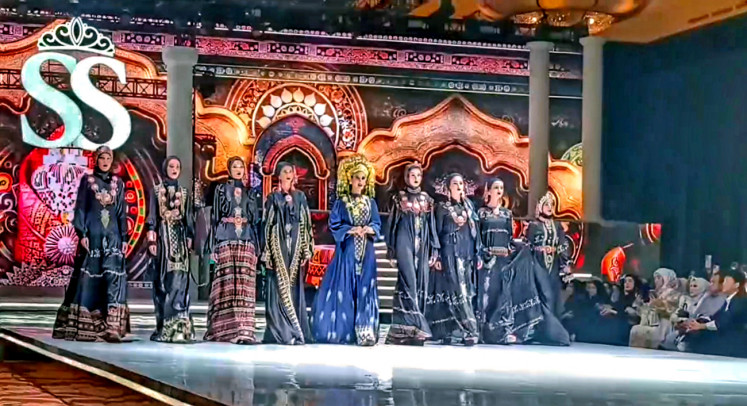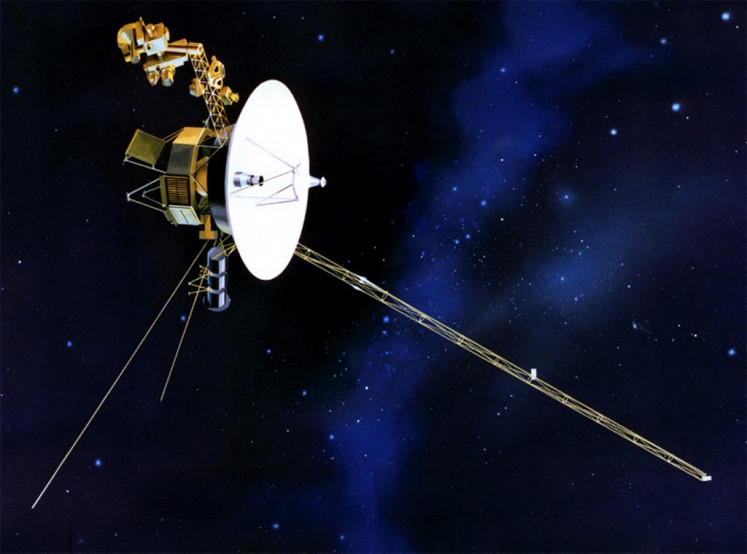Indonesian comics come to the fore
Through the platform of comics, many messages and visions in Indonesia have been spread.
Change Size
 Menjemput Ibu (Picking up Mother) by M. Fahmi (Galeri Nasional Indonesia/File)
Menjemput Ibu (Picking up Mother) by M. Fahmi (Galeri Nasional Indonesia/File)
A
professional thug called Neon decides to bury his past after he gets introduced to the world of Japanese manga. Realizing there is so much to read but so little time, Neon prays that he will live long enough to satisfy his thirst for manga. However, unfortunately, he dies in an accident, getting struck by a falling book shelf.
The single comic strip touches on many heavy issues, such as land conflicts and human rights, but keeps entertaining its readers with criticisms of expensive internet services and books, as well as lack of story creativity in Indonesian comics.
The comic strip by M. Iqbal, titled Pertobatan Preman (The Repentance of a Thug), was among hundreds submitted for consideration at this year’s Indonesia Art Awards (IAA).
Held by the Indonesian Fine Art Foundation (YSRI) and cigarette company Gudang Garam, the event focuses on merit within Indonesia’s burgeoning comic industry.
The exhibition itself, named “Dunia Komik” (Comic World), is running from April 2 to 18 at the National Gallery of Indonesia in Gambir, Central Jakarta, showcasing the works of 129 artists both esteemed and indie.
Out of the 350 initial entries that applied for the show, over 50 percent were relative “newcomer” artists, therefore showing that the medium is alive and well even out of the mainstream art world’s sight.
To help all participants develop their craft, head of the IAA’s jury committee, Jim Supangkat, who himself is an artist and art collector, said the exhibition provided the chance for comic artists to explore various forms that their art can take. This is important for comic artists, said Jim, as such artists are in his view still underappreciated in the Indonesian art world.
“What I like about this exhibition is that it encourages comic artists to look beyond comics as merely images and drawings. Several of the artists taking part have taken up this challenge, such as by creating installations and video projections,” he commented.
An interesting observation by the curator is the fact that the exhibition hosts various styles of comic artistry, whether they be the Japanese manga style, the realist style used by many Indonesian artists of yore seen in many period series, or the American or European clear line styles. “The comic artists would therefore realize that they are, indeed, artists,” Jim added.
The exhibition itself is a collection of comic strips hung all throughout the gallery’s main exhibition hall, both old and modern, with the modern artists seemingly receiving much of the emphasis.
Read also: Finding Indonesia in Marvel universe
Creations from esteemed cartoonists such as M. “Mice” Misrad of the famed Lagak Jakarta and Benny & Mice series were displayed along with the works of other young artists such as science fiction artist Dwiky KA and surrealist illustrator Ahmad Syarif Hidayatullah.
At the entrance area before the hall’s doors, a comprehensive timeline of Indonesian comics and their history were showcased, taking the viewer through the historical evolution of comics in Indonesia, starting from the birth of Indonesia’s first comic strip character that appeared in a Dutch-Indies newspaper in 1925 named Kromo, to the prevalence of comic strips in the digital era of today, led by such strips as Si Juki and Tahilalats.
The themes at the exhibition vary, from surreal, spacey suites to social commentaries relevant to today.
Fellow exhibition curator Hikmat Darmawan explains that comics are often overlooked as a vital and effective platform to show certain situations or tell certain commentaries that usually cannot be expressed in other forms. Its fluidity and accessibility is what makes it prevail in the public mind better.
It isn’t the first time that the gallery showcased an entire exhibition on comic art. In 1998, the gallery held the first of its kind, however, the context of that event was different.
“The older generation saw the Indonesian comic industry shatter because in the 1980s the market infrastructure was gradually destroyed as publishers as well as major bookstores and retailers did not want to carry comics unless they were suited for children. This therefore limited the scope of potential,” Hikmat said.
It was only after new industry artists started to emerge in the early 2000s that the medium found its true potential again, starting small from communities and independent shows.
“From there, knowledge and ideas were exchanged and the industry slowly came to life again,” Hikmat said.









